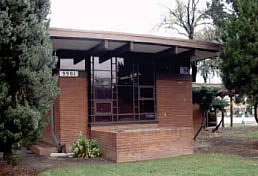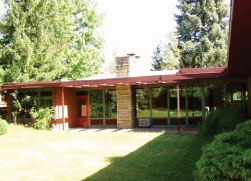Usonian
Typically associated with modern architecture of the 1940s, 1950s and 1960s, Usonia as a concept actually goes back to the turn of the twentieth century. Conceived by Frank Lloyd Wright around 1900, Usonia was a design philosophy that evolved over many years, coming to fruition in the 1930s. As his commissions for large, grand houses dropped off with the onset of the Great Depression, Wright looked for a way to address the need for affordable middle-class housing while employing a simple design. The result was an architecture he termed “Usonian,” which focused on the residents of a culturally reformed United States of North America. The Usonian houses were smaller than his sprawling Prairie style residences, contained little ornamentation and lacked basements or attics. These houses were arranged in zones, typically with three areas: living space, small bedrooms, and a kitchen-dining area. Built-in components and furniture allowed homeowners to appreciate the simpler, integrated space Wright intended.
The idea behind Usonia was about more than just designing smaller houses. It was about planning, nature, and simple design on a human scale. Wright’s concept for Usonia came about due to his increasing focus on community, planning, and serving human needs. He was interested in setting up decentralized communities with commercial, residential, educational, industrial, cultural, and recreational facilities. While his early concepts of these communities remained just that, many of the components were applied in a handful of places across the country, though not on the scale that he originally envisioned. As Wright did with the Prairie style of his earlier fame, he also incorporated the smaller Usonian house with the site. Wright integrated the house with the landscape and nature in an attempt to get away from box-like structures. Walls extended beyond the interior to the outside, intermingling the two. Large windows brought the outside in. Natural materials blended the house with the site and warm colors on the interior further contributed to the feeling of bringing the outdoors inside. Usonian houses were quite unlike the boxy, stark International Style houses that appeared to be dropped onto, rather than a part of, their location.

Commonly used in domestic buildings, this 1953 Victor Hornbein designed library is an excellent example of the Usonian style as applied to a public building. Hornbein Building, Aurora.
Also called Wrightian, the Usonian style has been adopted and adapted by numerous architects across the country. Not much is known about these houses as they are of more recent vintage and often have not been surveyed. Usonian is a recognized style found in such books as How to Complete the Ohio Historic Inventory and House Styles in America, The Old House Journal Guide to the Architecture of American Homes.
Common elements:
- dominant horizontal lines
- flat roofs with large overhangs
- integrated windows
- organic siting (a private side and an open side, usually facing south)
- carports
- zoned plans (three primary areas: living spaces, kitchen-dining areas at the intersection, and small bedrooms)
- open living areas
- concrete slab floors with integral gravity heating
- built-in components
- Inside-outside walls
- Central hearths


